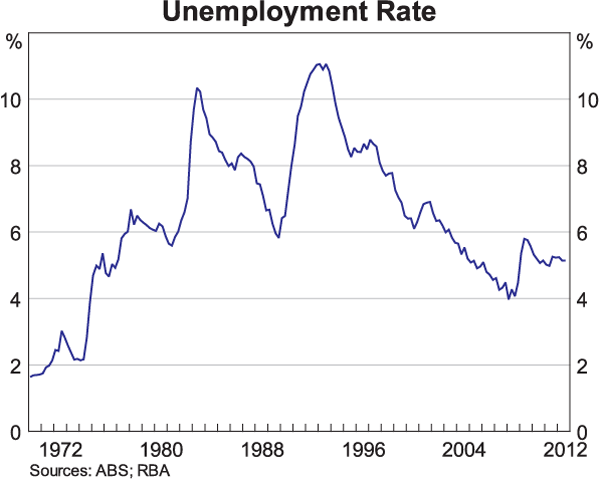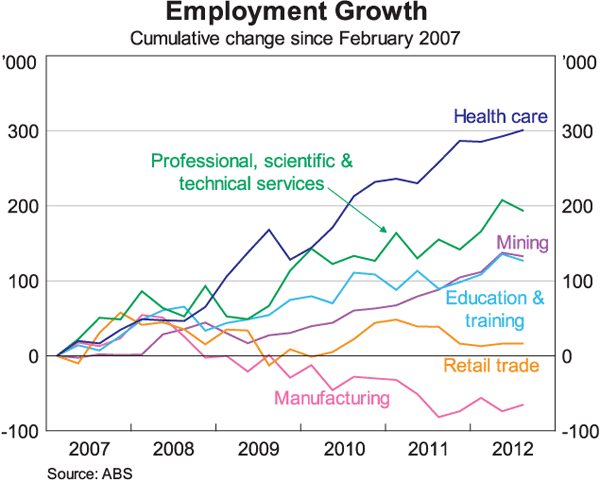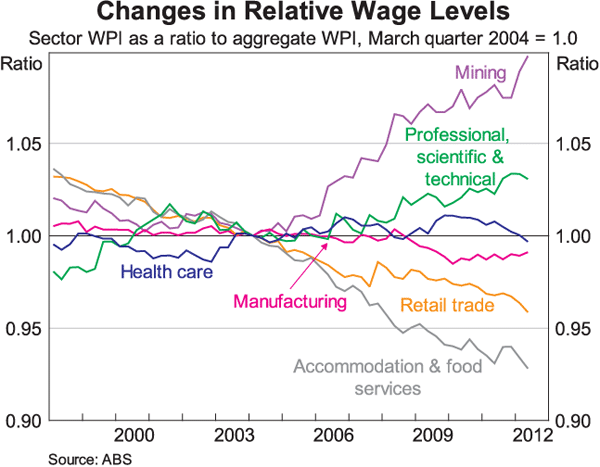- "Forecasts from the 2008 study [Off-shore and off work. September 2012 update] are on track to be realised in the absence of policy intervention.
- "More than 80,000 service [and financial] sector jobs have moved offshore since previous report.
- "With more than 20,000 jobs moving offshore each year we would expect between 700,000 and 1 million jobs to move off-shore in the next three decades.
- "Action is needed to address service sector [and financial] off-shoring crisis and boost competitive position of Australian service [and financial] industries".
----------
In a case of very good timing, RBA's deputy governor, Philip Lowe's speech to the Financial Services Institute of Australasia (FINSIA) on the same subject of off-shoring, broke the good news.
Lowe treats a number of interesting subjects, all of which would deserve consideration. For instance, he includes the following unemployment rate chart, which shows that, by recent standards, unemployment is not too bad.
 |
| Click for a larger image. |
No mention, however, is made to the fact that by late-1960s' standards, our current relatively low unemployment rate is high. No explanation is offered for this, either. But one can assume it has something to do with the abstract, slightly vague and undoubtedly mysterious "structural changes"
The bit of Lowe's speech that apparently caught the eye of journalists was "that since 2007, about 300,000 net new jobs had been created in healthcare, 200,000 in professional and scientific services and about 130,000 in each of the mining and education sectors".
Lowe included the following chart, illustrating this behaviour:
 |
| Click for a larger image. |
Note that, for instance, retail trade basically employs now the same quantity of people it did in 2007, regardless of the increment in the population: in other words, there are less people employed in this industry per capita. If you prefer, nowadays, it is harder to get one of these jobs.
The same conclusion applies, with more reason, to manufacturing.
Well, I suppose if one loses one's job in manufacturing, then one could try moving to a growth area, like healthcare, professional and scientific services or mining and education and training.
Upon a closer examination, however, the reader would agree that perhaps a job in professional and scientific services or education and training is not too realistic an option for an unemployed blue-collar worker: you need time and savings to get the qualifications; but even if you did get them, why would any employer prefer a middle-aged graduate to a much younger one?
You have two options left: mining and healthcare. Mining sounds like a long shot: even the "permabulls" seem to finally accept that mining has gone through the development stage, where large numbers of workers were required.
What about healthcare? That certainly seems an option. Mind you, not a top tier job (like doctor, or something) for the same reason that a professional/scientific services or education/training jobs are not realistic: qualification and age.
But a more modest healthcare job seems possible. And how much to they get paid? Lowe also offers a good chart:
 |
| Click for a larger image. |
Healthcare, in average, has not gained anything over the average pay since 1998.
In other words, if you were a blue-collar worker, you lost your manufacturing job, need now to struggle to get new qualifications (say, in healthcare), so that you can compete against younger candidates and, at best, if you succeed, you will have gained nothing.
Not so awesome, I'd say. And that without taking into account the predictions made by the Services and Financial Sector unions.
This may be just me, but if I were one of those former blue-collar workers, right now, I wouldn't be too happy.
Now, the question is, can we do something about it? To be honest, I don't think so, under capitalism, that is.
No comments:
Post a Comment